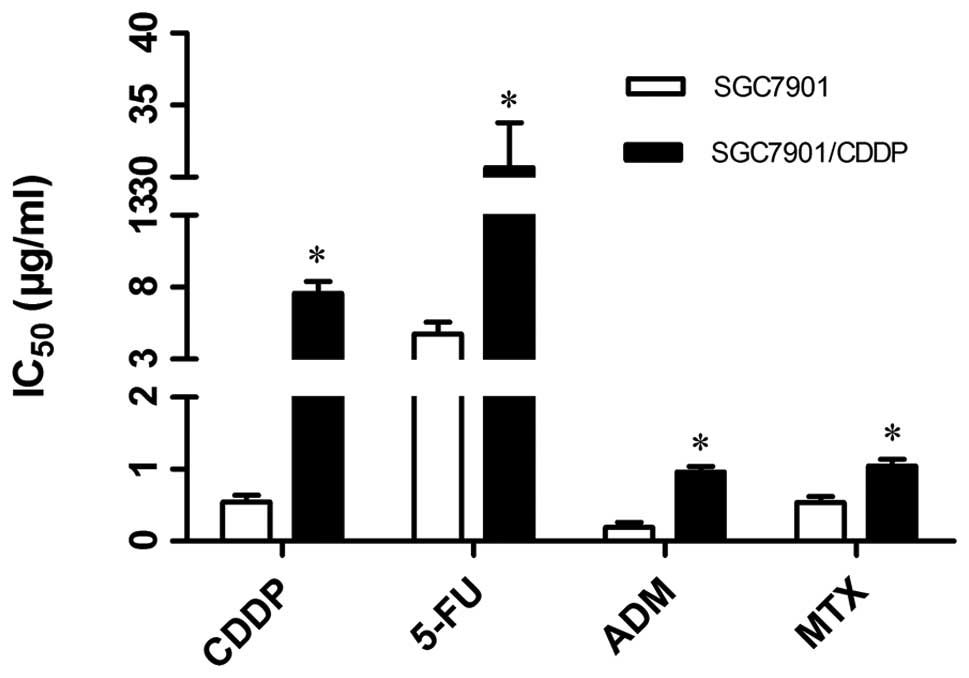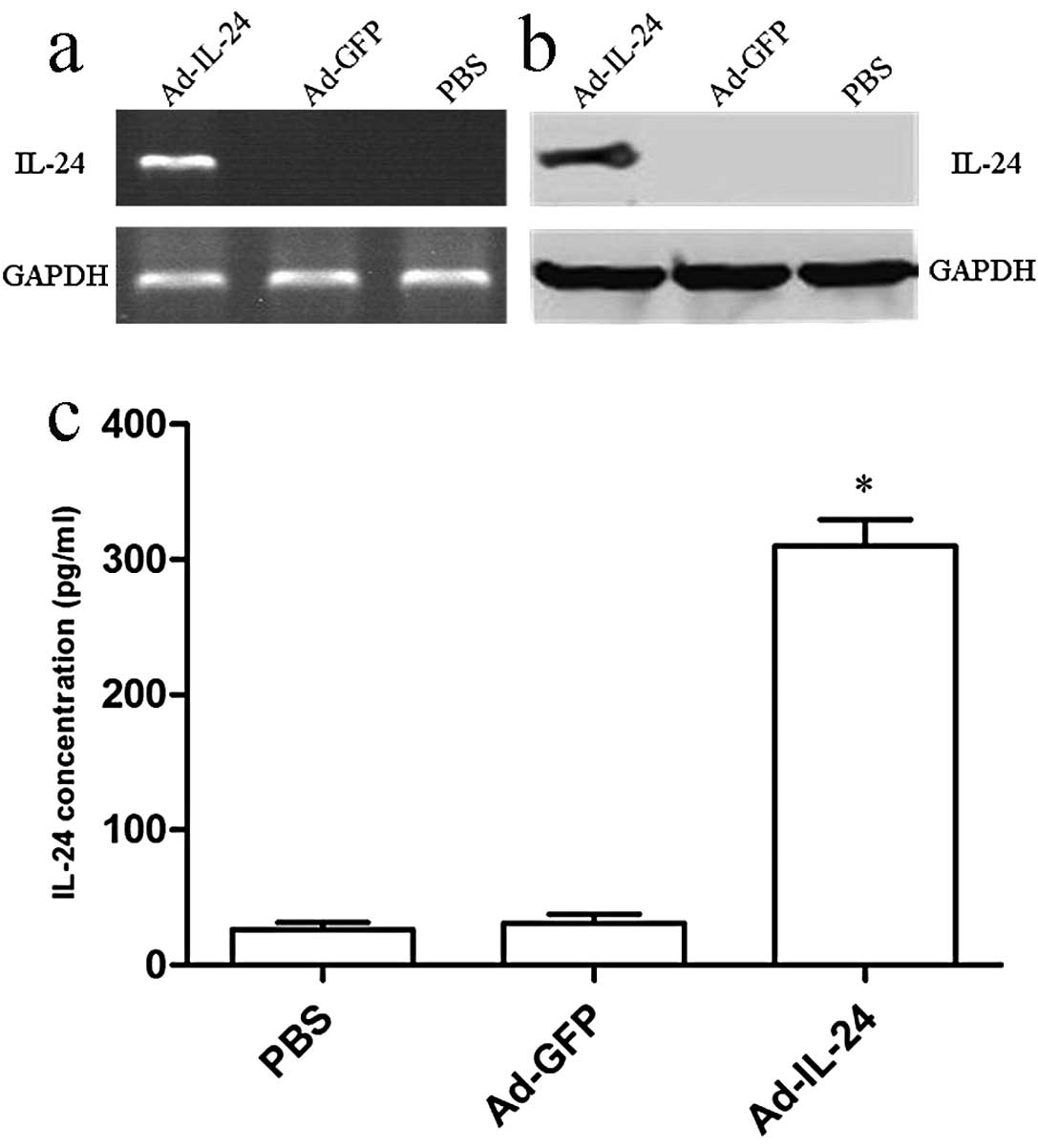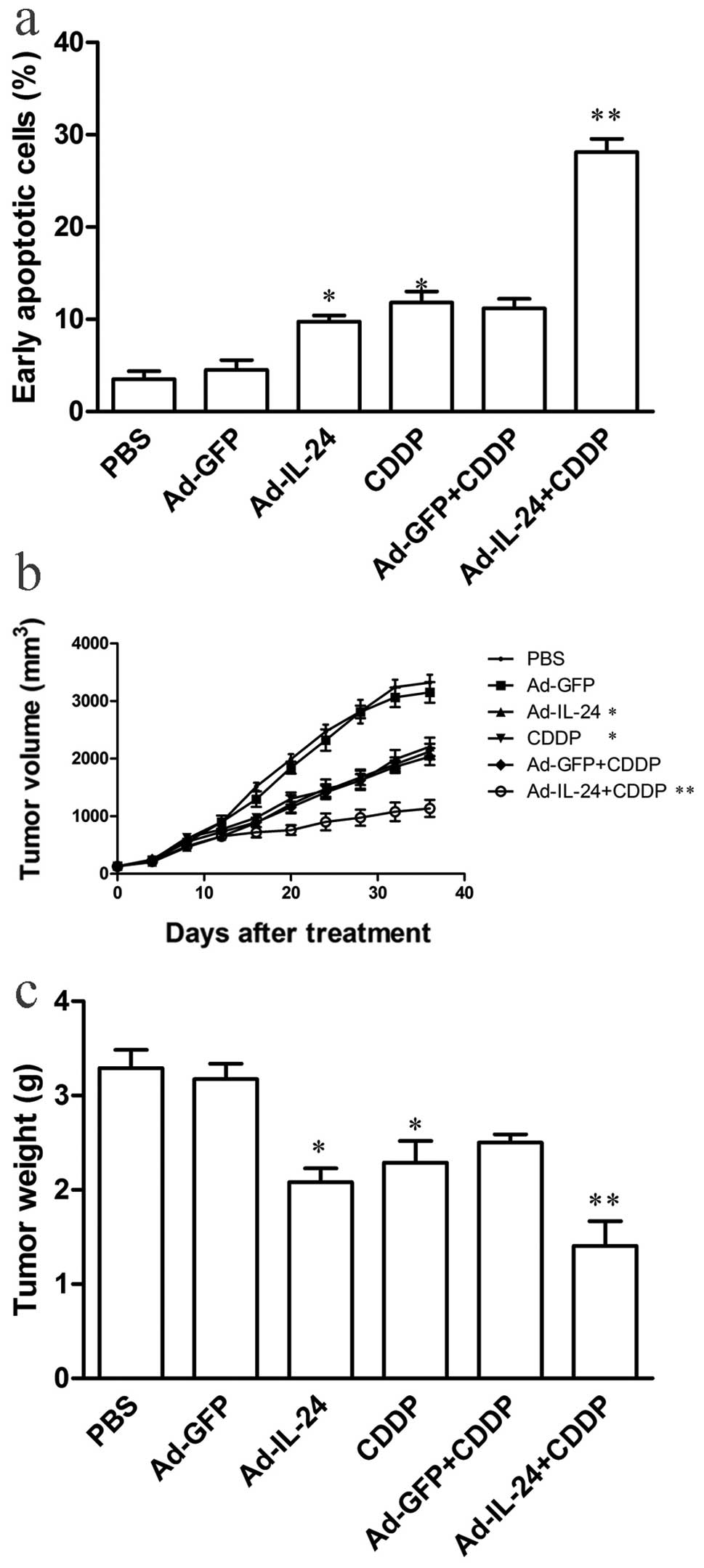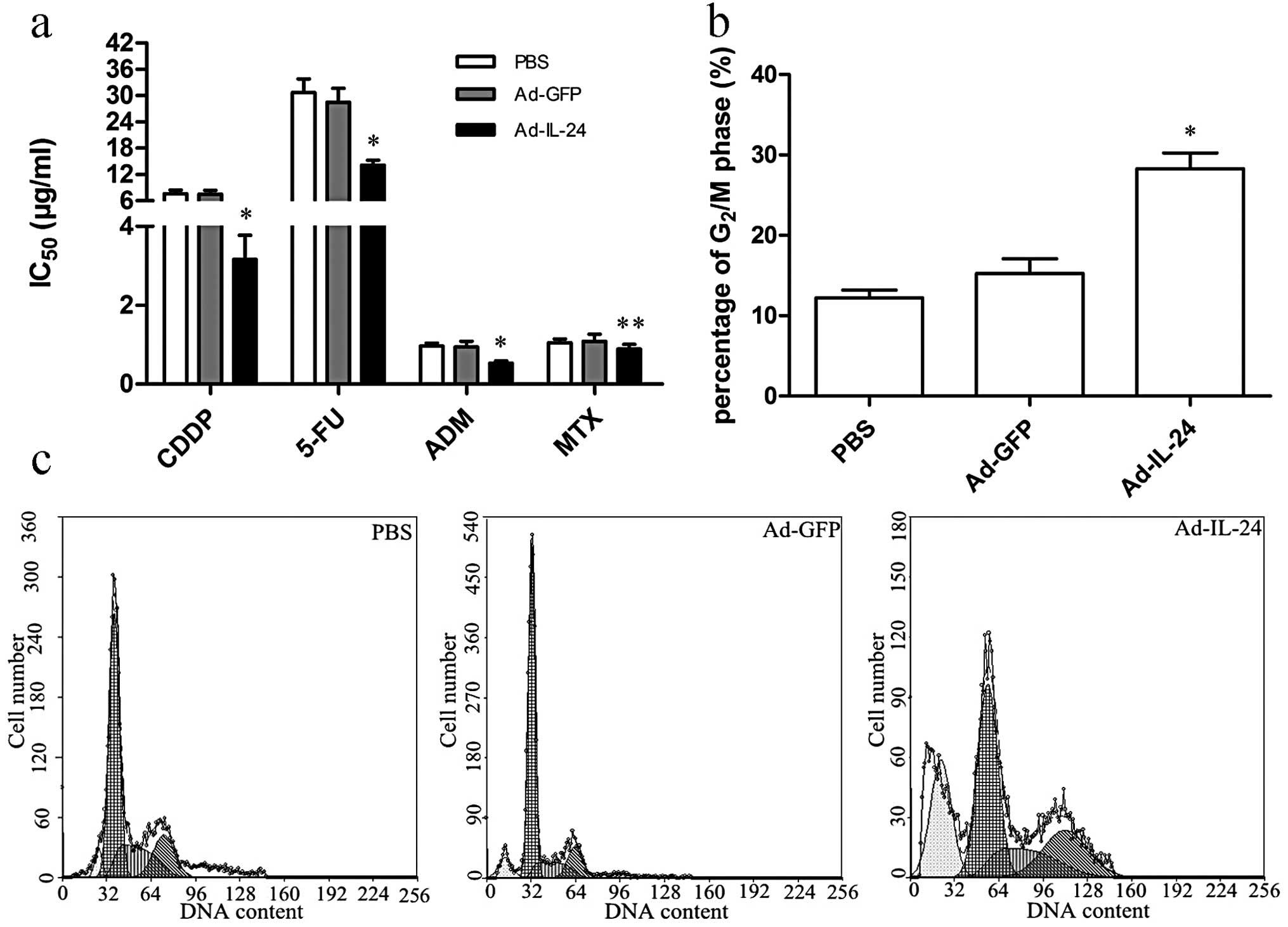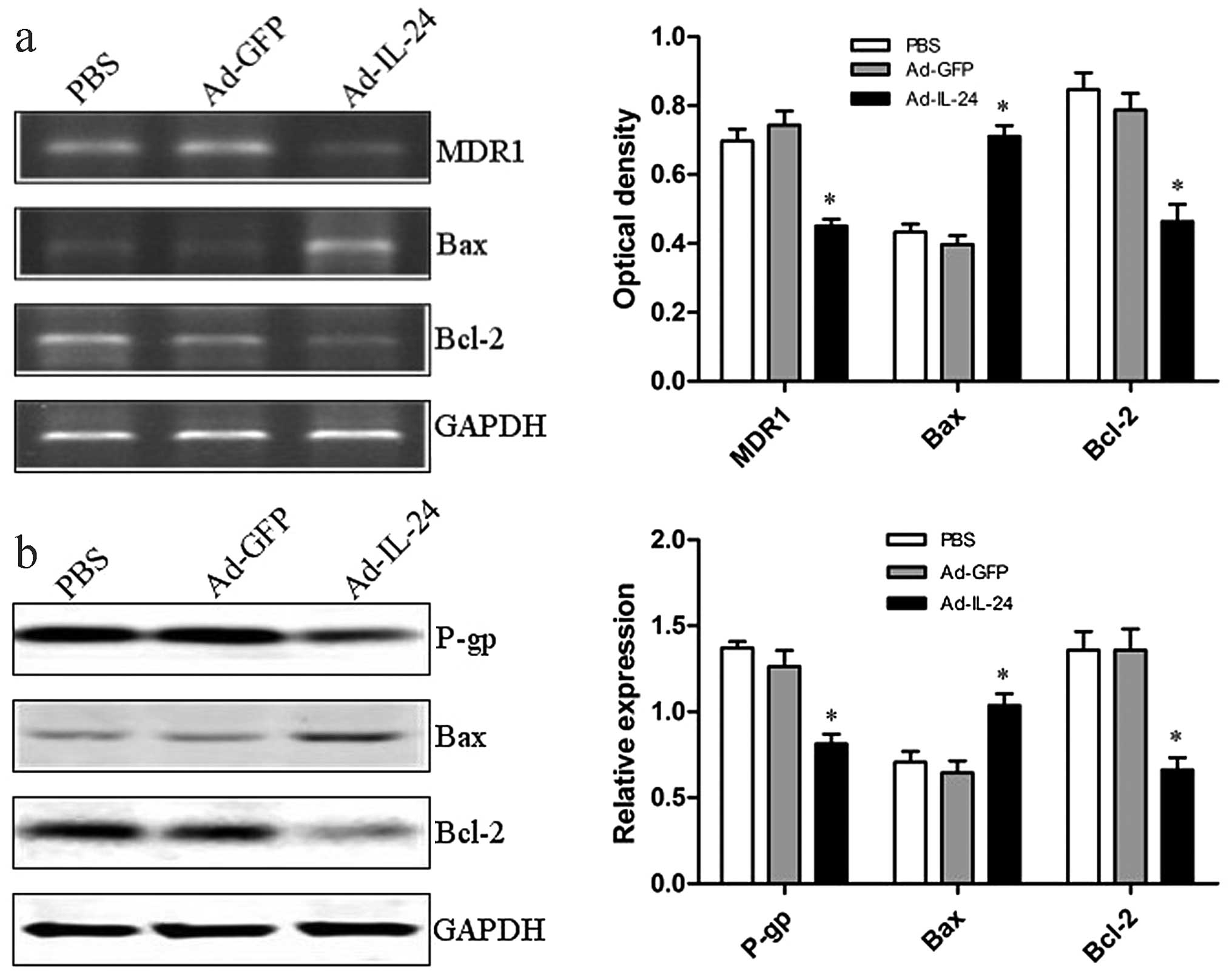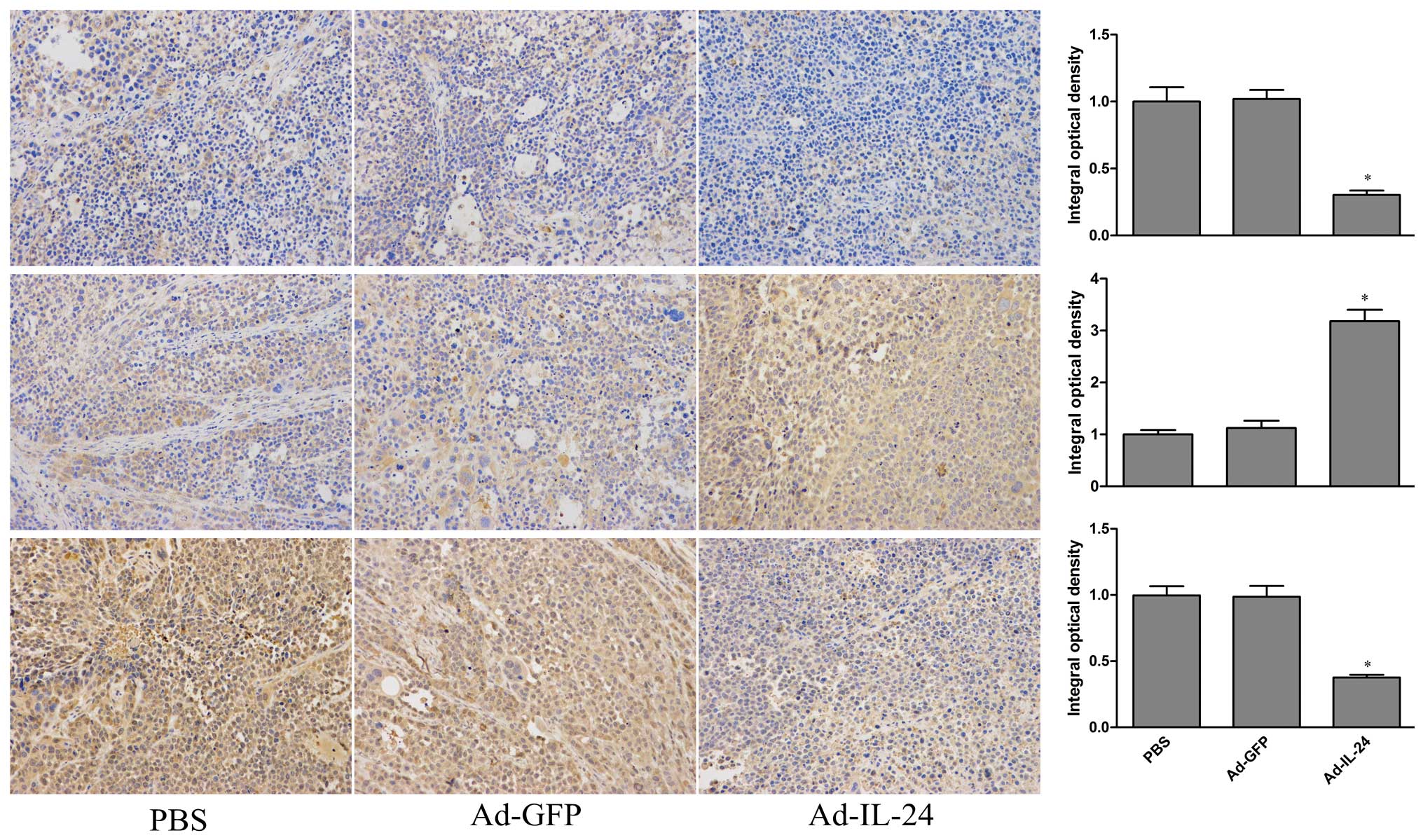Adenovirus-mediated IL-24 expression enhances the chemosensitivity of multidrug-resistantgastric cancer cells to cisplatin
- Authors:
- Published online on: August 26, 2013 https://doi.org/10.3892/or.2013.2695
- Pages: 2288-2296
Abstract
Introduction
Gastric cancer is the fourth leading cause of cancer-related death in the world (1). To date, chemotherapy is the most frequently used fundamental treatment for gastric cancer. However, the main barrier to successful chemotherapy is MDR caused by insensitivity to multiple chemotherapeutic agents after exposure to a single chemotherapeutic drug (2). For decades, the most representative consensus is the overexpression of drug efflux pumps (such as P-gp) occupying a critical position in development of MDR. Consequently, several innovative chemosensitizers against P-gp, such as verapamil, trifluoperazine and cyclosporine, have been found to enhance chemosensitivity of MDR phenotype cancer cells (3). However, the clinical application of these chemosensitizers showed disappointing results (4,5), indicating that there are some unknown molecules and mechanisms also responsible for MDR. Recent studies have verified that some novel factors including defective apoptosis pathway, enhanced DNA repair activity, or altered metabolism of drugs play a critical role in promoting formation of MDR (6). Though the underlying mechanisms have been deeply studied in vitro and in vivo(6–9), the precise mechanisms involved in MDR have not been fully characterized. Evidence so far suggest that mechanisms responsible for MDR in gastric cancer are likely to be multifaceted and extremely intricate. Thus, further investigation of the MDR mechanisms to find acceptable chemosensitizers for clinical application in human cancers, including gastric cancer is required.
Interleukin-24 (IL-24), a novel member of interleukin-10 family of cytokines, also known as melanoma differentiation associated gene-7 (mda-7), was first identified by using subtraction hybridization of cDNA libraries from actively proliferating human HO-1 melanoma cells versus interferon-β and mezerein-treated HO-1 cells (10). It can specifically induce apoptosis in a wide variety of malignant tumor cells exerting no discernible toxic effects towards normal cells by eliciting potent ‘antitumor bystander activity’ as a consequence of autocrine secretion (11), which has attracted particular attention from researchers worldwide. Subsequently studies demonstrated that expression of IL-24 was lost in a broad spectrum of malignant tumors including gastric cancer, whereas ectopic expression of this gene performed a ubiquitous growth inhibition, apoptosis induction, reversal malignant phenotype and terminal differentiation in a variety of cancers (10,12–17). These gratifying findings have led to the development of INGN241, a replication-incompetent IL-24-expressing adenovirus, which is currently in phase II/III clinical trials (18).
Previous studies showed that combination of chemotherapy, radiotherapy and other conventional therapies with gene therapy is a promising practice in cancer treatment (19–21). Furthermore, adenoviral p53 gene was in adjuvant use with conventional chemotherapy, radiation therapy, and surgery of lung and head and neck cancers (22). IL-24 has been reported to sensitize human colorectal cancer cells to doxorubicin and 5-fluorouracil, human melanoma cells to dacarbazine, and human hepatocellular carcinoma cells to 5-fluorouracil, respectively (3,17,23,24). In addition, our laboratory demonstrated that adenovirus-mediated IL-24 gene therapy could enhance chemosensitivity of MDR phenotype colon cancer cells to oxaliplatin (25). However, its chemosensitizing effects for human MDR phenotype gastric cancer cells so far have not been reported. Given this, we successfully established the CDDP-induced MDR phenotype gastric cancer cell subline and hypothesized that IL-24 gene may sensitize these human gastric cancer cells to cisplatin therapy. In this study, we also investigated the possible role of IL-24 in chemosensitizing of human gastric cancer cells and its underlying mechanisms.
Materials and methods
Adenoviral vectors, cell lines, reagents and mice
The Ad-IL-24 and Ad-GFP adenoviral vectors were constructed in our laboratory (26). The human embryonic kidney cell line QBI-293A was kindly provided by Professor Jiang Zhong of Fudan University (Shanghai, China). The human gastric cancer cell line SGC7901 was purchased from the American Type Culture Collection (ATCC, Rockville, MD, USA). The QBI-293A and SGC7901 cell lines were cultured in RPMI-1640 medium (Gibco, Shanghai, China) supplemented with 10% fetal bovine serum (FBS) (Hyclone, Logan, UT, USA). The TRIzol reagent and the reverse transcriptase MuMLV were purchased from Invitrogen (Shanghai, China). The cell counting kit-8 was purchased from the subsidiary of Dojindo Laboratories (Shanghai, China). The Annexin V-PE/7-AAD apoptosis detection kit was purchased from BD Biosciences (Shanghai, China). The in situ cell death detection kit was purchased from Roche Applied Science (Shanghai, China). The monoclonal anti-IL-24 antibody and human IL-24 enzyme-linked immunosorbent assay (ELISA) kit were purchased from R&D Systems (Shanghai, China). The antibodies specific for P-gp, Bax, Bcl-2 were from Cell Signaling Technology (Boston, MA, USA). The SuperEnhanced chemiluminescence detection kit was from Applygen Technologies Inc. (Beijing, China). The UltraSensitive™ SP kit was obtained from Maixin (Fuzhou, China). Chemotherapeutical drugs cisplatin (CDDP), 5-fluorouracil (5-FU), adriamycin (ADM) and methotrexate (MTX) were kindly provided by The First Hospital Affiliated of Soochow University (Suzhou, China). Additionally, female athymic nude mice were purchased from Shanghai Experimental Animal Center (Shanghai, China) and maintained in the animal facility at Soochow University according to the animal research committee’s guidelines of Soochow University.
Development of the MDR phenotype human gastric cancer cell subline SGC7901/CDDP
Gastric cancer SGC7901 cells were cultured in RPMI-1640 supplemented with 10% FBS overnight and then changed to cisplatin-containing medium to induce MDR by repeated selection of resistant clones of parental sensitive SGC7901 cells to stepwise increasing concentrations of cisplatin. After 4 months, the SGC7901 cells could stably grow in 1 μg/ml cisplatin-containing medium. To maintain the MDR phenotype, the 1 μg/ml cisplatin-containing medium was used in later MDR phenotype cell culture.
Transfection
To assess the optimal multiplicity of infection (MOI) for a maximal infection and transgene expression, human gastric cancer cells SGC7901/CDDP were infected with Ad-IL-24 and Ad-GFP at various MOIs (0, 1, 10, 25, 50, 100 and 200) for 24 h. The adenoviral infection efficiency was analyzed according to GFP expression by fluorescence microscopy. Furthermore, the IL-24 transgene expression mediated by adenoviral infection in SGC7901/CDDP cells was determined by using RT-PCR and western blot analysis.
RT-PCR analysis
Total RNA was extracted from Ad-IL-24- or Ad-GFP-infected and uninfected SGC7901/CDDP cells using TRIzol and then reversely transcribed into cDNA using Oligo d(T)18 as primer according to the manufacturer’s protocol. PCR amplification was carried out using these cDNA samples as templates and IL-24 primers (5′-GCACTCGAGCCATGAATTTTCAACAGAGGCTGCA-3′ and 5′-GCTTCTAGATCAGAGCTTGTAGAATTTCTG-3′) under conditions of an initia1 cycle at 94°C for 2 min and 72°C for 10 min followed by 35 cycles at 94°C for 50 sec, 58°C for 50 sec and 72°C for 55 sec and a final extension at 72°C for 10 min. The PCR products were separated in 1% agarose gels using electrophoresis with ethidium bromide staining. Subsequently, The GAPDH as well as multidrug resistant- and apoptosis-related genes MDR1, Bax and Bcl-2 were detected as the above protocols, the PCR reaction was carried out using the following primers (5′-GCGGCTCCGATACATGGTT-3′ and 5′-TGGCGAGCCTGGTAGTCAAT-3′ for MDR1; 5′-GGA TGCGTCCACCAAGAA-3′ and 5′-GCACTCCCGCCACAAAGA-3′ for Bax; 5′-TGTGGCCTTCTTTGAGTTCG-3′ and 5′-CTACCCAGCCTCCGTTATCC-3′ for Bcl-2; 5′-TTACTCCTTGGAGGCCATGTGGGCC-3′ and 5′-ACT GCCACCCAGAAGACTGTGGATGG-3′ for human GAPDH).
Western blot analysis
Total proteins was isolated from Ad-IL-24- or Ad-GFP-infected and uninfected SGC7901/CDDP cells and resolved in 12% sodium dodecyl sulfate-polyacrylamide gel electrophoresis (SDS-PAGE) and subsequently transferred onto a polyvinylidene difluoride membrane. After that, the membrane was incubated in 5% (w/v) non-fat dry milk in Tris-buffered saline containing 0.05% Tween-20 (TBST) for 1 h at 37°C and then further with a panel of primary antibodies specific for IL-24, P-gp, Bax, Bcl-2 and GAPDH (an internal control) in blocking solution for 1 h at 37°C. The membrane was then washed with TBST and incubated with a peroxidase horseradish peroxidase-conjugated secondary antibody in blocking solution for another 1 h at 37°C. After three washes with TBST, the positive bands were developed by using a SuperEnhanced chemiluminescence detection kit and visualized after exposure of the membranes to Kodak X-ray film.
ELISA analysis
The adenovirus-mediated secretory expression of IL-24 in SGC7901/CDDP cells was detected by ELISA analysis. Briefly, the SGC7901/CDDP cells (2.5×106) were infected with 100 MOI Ad-IL-24, Ad-GFP or without adenovirus (PBS) in 10 ml medium, respectively. After 24 h of treatment, the cellular culture supernatants generated from the three groups were collected, and the amount of IL-24 in above culture supernatants was analysed by ELISA using human IL-24 ELISA kit according to the manufacturer’s instructions.
CCK-8 assay
The in vitro resistance index of SGC7901/CDDP cells were analyzed by CCK-8 assay. Briefly, SGC7901 and SGC7901/CDDP cells (1×104 per well) were seeded in 96-well culture plates and incubated for 24 h at 37°C and then treated with CDDP, 5-FU, ADM and MTX in seven different concentrations for 48 h (see Results). The viability of SGC7901 and SGC7901/CDDP cells were then analyzed by using CCK-8 kit according to the manufacturer’s protocol. Similarly, the cells infected with Ad-IL-24 and Ad-GFP were also included for CCK-8 assay. The SGC7901/CDDP cells were infected with 100 MOI Ad-IL-24 or Ad-GFP or without adenovirus (PBS) for 24 h and then treated with CDDP, 5-FU, ADM and MTX for 48 h and then subjected to CCK-8 assay. Inhibitory rate (%) was calculated using the formula: 1 − (ODexperiments/ODcontrols) ×100%; Resistance index: IC50(SGC7901/CDDP)/IC50(SGC7901) and Reversion index: IC50(PBS)/IC50(Ad-IL-24).
Flow cytometric analysis of cell cycle alteration
The SGC7901/CDDP human gastric cancer cells (1×106) were cultured with 100 MOI Ad-IL-24, Ad-GFP or without adenovirus (PBS), respectively. After 48 h, the infected and uninfected SGC7901/CDDP cells were trypsinized and washed in cold PBS, then subjected to cold 70% ethanol for 12 h, and the cells were stained with propidium iodide for cell cycle analysis by flow cytometry. All experiments were repeated three times.
Analysis of in vitro and in vivo chemosensitizing effects
To test the chemosensitizing effects of Ad-IL-24 in vitro and in vivo, the following groups were studied: PBS+SGC7901/CDDP (PBS), Ad-GFP+SGC7901/CDDP (Ad-GFP), Ad-IL-24+SGC7901/CDDP (Ad-IL-24), CDDP+SGC7901/CDDP (CDDP), Ad-GFP+CDDP+SGC7901/CDDP (Ad-GFP+CDDP) and Ad-IL-24+CDDP+SGC7901/CDDP (Ad-IL-24+CDDP). Firstly, we investigated in vitro effects. The SGC7901/CDDP cells (2.5×105) were cultured in 6-well culture plates (marked A, B, C, D, E and F, respectively), After 24 h, 100 MOI Ad-IL-24 was added in A and B well, 100 MOI Ad-GFP was added in C and D well, equivalent PBS was added in E and F well as controls. After next 24 h, 2.5 μg/ml CDDP was added in A, C and E wells. Two days later, all treatment groups were harvested and washed in cold PBS, the apoptosis rate was assessed by flow cytometry using the Annexin V-PE/7-AAD apoptosis detection kit according to the manufacturer’s protocol. Briefly, the SGC7901/CDDP cells (2.5×105) were incubated with 5 μl of Annexin V-PE and 5 μl 7-AAD in 100 μl of 1X Annexin V-binding buffer at room temperature. After incubating for 15 min, 400 μl of 1X binding buffer was added, and the apoptotic cells were analyzed by flow cytometry.
Secondly, we investigated in vivo effects. The female athymic nude mice were subcutaneously (s.c.) inoculated into the armpits of their right anterior limbs with 2×106 human SGC7901/CDDP cells. After the tumor mass reached a mean tumor volume of ~100 mm3, Ad-IL-24, Ad-GFP or PBS were given once every 3 days by intratumoral injection for 36 days. From days 7–14 and 21–28, 4.5 mg/kg of CDDP was given via tail vein injection weekly. Tumor progression and regression were monitored and tumor volume was measured with a caliper every four days. The tumor volume was calculated by a formula, i.e., ab2/2, where a is the larger and b is the smaller of the two dimensions. The tumor-bearing mice were then sacrificed at day 36 after the treatments and tumor xenograft tissues were removed, weighed, fixed by 10% neutral formalin, and then embedded in paraffin for hematoxylin and eosin staining and immunohistochemical analysis.
Immunohistochemistry
Expression of P-gp, Bax and Bcl-2 proteins of PBS, Ad-GFP and Ad-IL-24 groups in human gastric cancer xenograft tissues was analyzed by using immunohistochemistry with an UltraSensitive SP kit according to the manufacturer’s instructions. The presence of buffy or brown diaminobenzidine precipitates is indicative of positive reactivity. The integral optical density (IOD) of immunohistochemical intensity was analyzed by Image-Pro Plus 6.0 software (Media Cybernetics, Bethesda, MD, USA).
Statistical analysis
All data were presented as the mean ± SD. The significant difference between two groups was evaluated by using Student’s t-test and one-way or two-way repeated measures analysis of variance and multiple comparisons with SPSS 10.0 software (SPSS, Chicago, IL, USA). A value of P<0.05 was considered to be significant.
Results
Development of the CDDP-induced MDR phenotype gastric cancer cell subline SGC7901/CDDP
To obtain CDDP-induced MDR phenotype gastric cancer cell subline SGC7901/CDDP, we selected the SGC7901 cells repeatedly under increased cisplatin concentrations from 0.04 μg/ml to 1 μg/ml in a 4 months period. The MDR phenotype gastric cancer cells could grow stably in 1 μg/ml cisplatin-containing medium. To maintain the MDR phenotype, 1 μg/ml cisplatin-containing medium was used in later MDR phenotype cell cultures. We first performed CCK-8 assay to detect the changed viability in SGC7901/CDDP cells. The data showed that SGC7901/CDDP cells acquired 14.03-, 6.47-, 5.06- and 1.94-fold resistance to CDDP, 5-FU, ADM and MTX compared to parental SGC7901 cells, respectively (P<0.05; Fig. 1).
Stable expression of IL-24 in vitro
To assess the optimal MOI for a maximal transgene expression with minimal adenovirus itself-caused cytotoxicity, SGC7901/CDDP cells were infected with Ad-IL-24 or Ad-GFP at different MOIs (see Materials and methods) and examined under fluorescence microscopy. More than 90% of GFP expression was found in the Ad-IL-24- or Ad-GFP-infected SGC7901/CDDP cells at MOI of 100 or above, whereas the GFP expression was not found in uninfected SGC7901/CDDP cells. Additionally, there was rarely adenovirus-elicited cytotoxic effect in 100 MOI blank Ad-GFP-infected SGC7901/CDDP cells (data not shown). Furthermore, adenovirus-mediated exogenous IL-24 tumor suppressor gene and protein was significant expressed at 100 MOI in Ad-IL-24-infected SGC7901/CDDP cells but not in Ad-GFP-infected and uninfected SGC7901/CDDP cells (Fig. 2a and b), indicating that IL-24 is expressed in Ad-IL-24-transfected SGC7901/CDDP cells at transcriptional and translational levels. In addition, a significant amount of secreted IL-24 was found in the culture supernatants of Ad-IL-24 infected SGC7901/CDDP cells but not in the Ad-GFP infected or uninfected SGC7901/CDDP cells (P<0.05; Fig. 2c). These results suggested that 100 MOI can be used as an optimal dose for the adenovirus-mediated IL-24 gene induction and transgene expression in human gastric cancer SGC7901/CDDP cells.
Ad-IL-24 significantly enhances chemosensitivity of SGC7901/CDDP cells to cisplatin in vitro and in vivo
Based on the development of MDR phenotype SGC7901/CDDP cells, we further explored whether Ad-IL-24 had chemosensitizing effects on SGC7901/CDDP cells. In vitro, Annexin V-PE and 7-AAD double-positive staining by flow cytometry showed that Ad-IL-24 plus CDDP could induce greater early apoptosis (28.13%) than Ad-IL-24 (9.77%) or CDDP (10.83%) alone (P<0.05 Fig. 3a), indicating that Ad-IL-24 treatment could significantly enhance the chemosensitivity of SGC7901/CDDP cells to cisplatin. To further address the potential chemosensitizing effects of Ad-IL-24 on SGC7901/CDDP cells, in vivo, we injected SGC7901/CDDP cells into athymic nude mice and then injected Ad-IL-24, Ad-GFP or PBS and treatment continued with or without CDDP. The data showed that Ad-IL-24 plus CDDP significantly reduced tumor volume from days 12–36 compared to the other groups (P<0.05; Fig. 3b). Similarly, the tumors weight also showed a difference in Ad-IL-24 plus CDDP treatment group (P<0.05; Fig. 3c), indicating that Ad-IL-24 also has a robust chemosensitizing effect on gastric cancer SGC7901/CDDP cell xenografts in vivo in an athymic nude mouse model.
Ad-IL-24 elicits chemosensitizing effect by induction of cell cycle alteration and reversal of expression of multidrug resistant- and apoptosis-related proteins
We first investigated the changes in IC50 elicited by Ad-IL-24 in MDR phenotype gastric cancer cells. The SGC7901/CDDP cells were infected with Ad-IL-24 or Ad-GFP at 100 MOI, cell viability was determined on the fourth day by using CCK-8 assay. Compared with Ad-GFP and PBS treatment groups, the IC50 (Fig. 4a) of the Ad-IL-24-infected SGC7901/CDDP cells to CDDP, 5-FU, ADM (not MTX) was significantly decreased. To further address the underlying mechanisms that may be responsible for Ad-IL-24-mediated chemosensitizing effect. We analyzed the cell cycle distribution and the changes of multidrug resistant- and apoptosis-related protein expression. The cell cycle alteration of SGC7901/CDDP cells in Ad-IL-24 or Ad-GFP or PBS treatment group was analyzed by flow cytometry.
As shown in Fig. 4b and c, the proportion of SGC7901/CDDP cells in the G2/M phase was significant increased in Ad-IL-24 treatment group compared with Ad-GFP and PBS groups (P<0.05). Subsequently, the expression of MDR- and apoptosis-related genes/proteins (MDR1/P-gp, Bax/Bax and Bcl-2/Bcl-2) were detected by RT-PCR and western blot analysis in these cells. Our results showed that MDR1/P-gp and Bcl-2/Bcl-2 were downregulated, whereas Bax/Bax was upregulated in Ad-IL-24-treated SGC7901/CDDP cells compared to PBS and Ad-GFP groups (P<0.05; Fig. 5a and b). Furthermore, expression of multidrug resistant-related proteins P-gp and apoptosis-related proteins Bax and Bcl-2 was also modulated in nude xenograft tissues (P<0.05; Fig. 6). Those results indicate that Ad-IL-24 is a strong chemosensitizer for MDR phenotype gastric cancer SGC7901/CDDP cells.
Discussion
Chemotherapy is one of the most conventional therapeutic strategies for human cancers, but MDR is frequently a major impediment to the successful use of cancer chemotherapy (27). MDR refers to phenomenon by which cancer cells that have been exposed to a certain chemotherapeutic drug, develop cross-resistance to a variety of functionally unrelated reagents. Naturally, MDR plays a mainstay role in chemoresistance of gastric cancer treatment. Different drugs may finally induce the MDR phenotype but through various signaling pathways, consequently leading to apparently different expression or functional changes of involved molecules. Previous studies have shown that several known proteins (such as P-glycoprotein, RhoE, GAS1, thymidylate synthase Bax and Bcl-2) play an important role in development of VCR-, 5-fluorouracil- or doxorubicin-based MDR phenotype gastric cancer cells (6,28–31), therefore, we speculate that different chemosensitizers may work through these known or some unknown ways to restore chemosensitivity of tumor MDR cells. Cisplatin, cis-diamminedichloroplatinum (CDDP), is deemed to be the ‘penicillin of cancer drugs’ due to its universal, early, and effective treatment for many cancers, including gastric cancer (32). However, the inherent or acquired resistance of tumors to CDDP therapy is a major clinical problem. The dose that is necessary to overcome even a small increase in cellular resistance can result in severe cytotoxicity in normal cells. Given this, it is imperative to explore novel chemosensitizers to reduce drug dosage, minimize side effects, enhance the efficacy of therapy, and promote the application of cisplatin in MDR phenotype cancer therapy.
Gene therapy provides a viable option, especially when used with a cancer-selective apoptosis-inducing gene, such as interleukin-24 (IL-24), a unique member of the IL-10-related cytokine gene family, exhibits nearly ubiquitous antitumor properties in vitro and in vivo(11). Unlike other tumor suppressors, the IL-24 unique aspects lie in its selective induction of apoptosis in cancer cells, profound ‘bystander’ activity by the secreted IL-24 protein, potent antitumor immune response. Some studies demonstrated that the cytotoxic activity of IL-24 gene did not depend on the status of other tumor suppressor genes, such as p53, Rb and ras (33). Furthermore, IL-24 exhibits strong chemosensitizing effects in broad-spectrum MDR phenotype cancer cells (3,17,23,24) and promising results in patients with multiple solid tumors in phase I clinical trials (34). These exciting findings indicate that IL-24 is likely to be a potent nontoxic chemosensitizer for eliminating MDR in tumor cells.
In the current study, we first established a CDDP-induced MDR phenotype gastric cancer subline SGC7901/CDDP by repeated selection and found that MDR promoted resistance of gastric cancer cells to 20 times CDDP treatment or other anticancer drugs, such as 5-FU, ADM or MTX. Then, we assessed the chemosensitizing effects of Ad-IL-24 gene in gastric cancer cells in vitro and in vivo. The results demonstrated that ectopic IL-24 expression decreased the IC50 of CDDP, 5-FU, and ADM (not MTX). Generally, cellular apoptosis often occurs after cell cycle arrest (35), and the anticancer and chemosensitizing mechanism of many treatments is mediated by the induction of cell cycle-specific apoptosis. In our study, we found that Ad-IL-24 significantly increased the percentage of SGC7901/CDDP cells in G2/M phase. Ad-IL-24 plus CDDP enhanced the induction of apoptosis in SGC7901/CDDP cells in vitro, and elicited a significant tumor suppression effect in vivo further indicating that Ad-IL-24 could be a potent model of adjuvant chemotherapy for gastric cancer.
Of the 48 human ATP-binding cassette transport proteins (36), P-glycoprotein (P-gp) is the best-known and principal mediator of MDR (37,38). It extrudes the chemotherapeutic agents out of cancers by using the energy of ATP hydrolysis, resulting in lower intracellular drug concentration and the decline of drug efficacy (39), therefore, is a thorny problem in cancer chemotherapy and inhibition of P-gp expression may restore chemosensitivity of cancer cells to anticancer drugs. In our study, overexpression of IL-24 downregulated P-gp expression, and Ad-IL-24 decreased the IC50 of gastric cancer cells SGC7901/CDDP to CDDP, 5-FU, ADM (not MTX). These results demonstrated that decreased expression of P-gp could be a mainstay chemosensitizing pathway. Additionally, Bcl-2 family is a key player in the mitochondrial pathway of apoptosis, which consists of more than 20 members of pro-apoptotic proteins and anti-apoptotic proteins (40). A previous study showed that apoptosis-related proteins (such as Bax and Bcl-2) are also key factors responsible for MDR (30,41–43). The ratio of Bcl-2 family molecules, such as Bcl-2/Bax constitutes the threshold of susceptibility to apoptosis, which promotes pore formation in the mitochondrial outer membrane, loss of mitochondrial integrity, and the release into the cytosol of cytochrome c followed by the cleavage of caspase-9, leading to the activation of intrinsic apoptotic pathway. Our current study demonstrated that Ad-IL-24 significantly induced expression of pro-apoptotic Bax protein, but inhibited expression of apoptosis-suppressing proteins Bcl-2 in vitro and in vivo. Furthermore, Ad-IL-24 plus CDDP enhanced induction of apoptosis in vitro SGC7901/CDDP cells and elicited significant tumor suppression of in vivo of SGC7901/CDDP xenograft tissues. These results demonstrated that intrinsic apoptotic pathway could be another key pathway for Ad-IL-24-elicited chemosensitizing in gastric cancer.
Recent evidence has shown that PI3K/Akt, a crucial effectors of the oncogenic signaling pathway, plays a key role in the MDR of gastric cancer cells, and altered expression of P-gp, Bax, and Bcl-2 might be responsible for the PI3K/Akt-induced drug resistance in AGS cells (44–46). Coincidentally, our investigation demonstrated that Ad-IL-24 restores chemosensitivity via modulating the expression of P-gp, Bax, and Bcl-2 in MDR phenotype gastric cancer cells. On the basis of the above evidence, it is believed that PI3K/Akt pathway is very likely to be involved in the Ad-IL-24-mediated chemosensitizing effects for gastric cancer. However, our study is just a proof-of-principle and further study will be performed to verify whether PI3K/Akt or some other unknown signaling pathways participate in IL-24-enhanced chemosensitivity in gastric cancer cells.
Acknowledgements
This work was supported by grants from Medical Science and Technology Development Foundation, Suzhou Department of Technology Bureau (no. YJS0916), Medical Science and Technology Development Foundation, Jiangsu, Department of Health (no. H 201013 and H 201209).
Abbreviations:
|
MDR |
multidrug resistance |
|
P-gp |
P-glycoprotein |
|
RT-PCR |
reverse transcriptase polymerase chain reaction |
|
IC50 |
50% inhibitory concentration |
References
|
Jemal A, Bray F, Center MM, Ferlay J, Ward E and Forman D: Global cancer statistics. CA Cancer J Clin. 61:69–90. 2011. View Article : Google Scholar | |
|
Szakacs G, Paterson JK, Ludwing JA, Booth-Genthe C and Gottesman MM: Targeting multidrug resistance in cancer. Nat Rev Drug Discov. 5:219–234. 2006. View Article : Google Scholar : PubMed/NCBI | |
|
Emdad L, Lebedeva IV, Su ZZ, Sarkar D, Dent P, Curiel DT and Fisher PB: Melanoma differentiation associated gene-7/interleukin-24 reverses multidrug resistance in human colorectal cancer cells. Mol Cancer Ther. 6:2985–2994. 2007. View Article : Google Scholar : PubMed/NCBI | |
|
Di Nicolantonio F, Knight LA, Glaysher S, Whitehouse PA, Mercer SJ, Sharma S, Mills L, Prin A, Johnson P, Charlton PA, Norris D and Cree IA: Ex vivo reversal of chemoresistance by tariquidar (XR9576). Anticancer Drugs. 15:861–869. 2004.PubMed/NCBI | |
|
Robert J and Jarry C: Multidrug resistance reversal agents. J Med Chem. 46:4805–4817. 2003. View Article : Google Scholar | |
|
Xia L, Zhang D, Du R, Pan Y, Zhao L, Sun S, Hong L, Liu J and Fan D: miR-15b and miR-16 modulate multidrug resistance by targeting BCL-2 in human gastric cancer cells. Int J Cancer. 123:372–379. 2008. View Article : Google Scholar : PubMed/NCBI | |
|
Filipits M: Mechanisms of cancer: multidrug resistance. Drug Discov Today Dis Mech. 1:229–234. 2004. View Article : Google Scholar | |
|
Shi Y, Zhai H, Wang X, Han Z, Liu C, Lan M, Du J, Guo C, Zhang Y, Wu K and Fan D: Ribosomal proteins S13 and L23 promote multidrug resistance in gastric cancer cells by suppressing drug-induced apoptosis. Exp Cell Res. 296:337–346. 2004. View Article : Google Scholar : PubMed/NCBI | |
|
Zhao Y, You H, Liu F, An H, Hi Y, Yu Q and Fan D: Differentially expressed gene profiles between multidrug resistant gastric adenocarcinoma cells and their parental cells. Cancer Lett. 185:211–218. 2002. View Article : Google Scholar : PubMed/NCBI | |
|
Jiang H, Su ZZ, Lin JJ, Goldstein NI, Young CS and Fisher PB: The melanoma differentiation associated gene mda-7 suppresses cancer cell growth. Proc Natl Acad Sci USA. 93:9160–9165. 1996. View Article : Google Scholar : PubMed/NCBI | |
|
Dash R, Bhutia SK, Azab B, Su ZZ, Quinn BA, Kegelmen TP, Das SK, Kim K, Lee SG, Park MA, Yacoub A, Rahmani M, Emdad L, Dmitriev IP, Wang XY, Sarkar D, Grant S, Dent P, Curiel DT and Fisher PB: Mda-7/IL-24: A unique member of the IL-10 gene family promoting cancer-targeted toxicity. Cytokine Growth Factor Rev. 21:381–391. 2010. View Article : Google Scholar : PubMed/NCBI | |
|
Gopalan B, Litvak A, Sharma S, Mhashilkar AM, Chada S and Ramesh R: Activation of the Fas-FasL signaling pathway by mda-7/IL-24 kills human ovarian cancer cells. Cancer Res. 65:3017–3024. 2005.PubMed/NCBI | |
|
Li YJ, Liu G, Li Y, Vecchiarelli-Federico LM, Liu JC, Zacksenhaus E, Shan SW, Yang BB, Li Q, Dash R, Fisher PB, Archer MC and Ben-David Y: mda-7/IL-24 expression inhibits breast cancer through up-regulation of growth arrest-specific gene-3 (gas 3) and disruption of β1 integrin function. Mol Cancer Res. 11:593–603. 2013.PubMed/NCBI | |
|
Jiang H, Lin JJ, Su ZZ, Goldstein NI and Fisher PB: Subtraction hybridization identifies a novel melanoma differentiation associated gene, mda-7, modulated during human melanoma differentiation, growth and progression. Oncogene. 11:2477–2486. 1995. | |
|
Xu S, Oshima T, Imada T, Masuda M, Debnath B, Grande F, Garofalo A and Neamati N: Stabilization of MDA-7/IL-24 for colon cancer therapy. Cancer Lett. 335:421–430. 2013. View Article : Google Scholar : PubMed/NCBI | |
|
Pataer A, Chada S, Roth JA, Hunt KK and Swisher SG: Development of Ad-mda-7/IL-24-resistant lung cancer cell lines. Cancer Biol Ther. 7:103–108. 2008. View Article : Google Scholar : PubMed/NCBI | |
|
Jiang G, Liu YQ, Wei ZP, Pei DS, Mao LJ and Zheng JN: Enhanced anti-tumor activity by the combination of a conditionally replicating adenovirus mediated interleukin-24 and dacarbazine against melanoma cells via induction of apoptosis. Cancer Lett. 294:220–228. 2010. | |
|
Tong AW, Nemunaitis J, Su D, Zhang Y, Cunningham C, Senzer N, Netto G, Rich D, Mhashilkar A, Parker K, Coffee K, Ramesh R, Ekmekcioglu S, Grimm EA, van Wart Hood J, Merritt J and Chada S: Intratumoral injection of INGN241, a nonreplicating adenovector expressing the melanoma-differentiation associated gene-7 (mda-7/IL24): biologic outcome in advanced cancer patients. Mol Ther. 11:160–172. 2005. View Article : Google Scholar | |
|
Xie Y, Sheng W, Miao J, Xiang J and Yang J: Enhanced antitumor activity by combining an adenovirus harboring ING4 with cisplatin for hepatocarcinoma cells. Cancer Gene Ther. 18:176–188. 2011. View Article : Google Scholar : PubMed/NCBI | |
|
Nishikawa T, Ramesh R, Munshi A, Chada S and Meyn RE: Adenovirus-mediated mda-7(IL-24) gene therapy suppresses angiogenesis and sensitizes NSCLC xenograft tumors to radiation. Mol Ther. 9:818–828. 2004. View Article : Google Scholar : PubMed/NCBI | |
|
Zhang X, Cheung RM, Komaki R, Fang B and Chang JY: Radiotherapy sensitization by tumor-specific TRAIL gene targeting improves survival of mice bearing human non-small cell lung cancer. Clin Cancer Res. 11:6657–6668. 2005. View Article : Google Scholar : PubMed/NCBI | |
|
Moon C, Oh Y and Roth JA: Current status of gene therapy for lung cancer and head and neck cancer. Clin Cancer Res. 9:5055–5067. 2003.PubMed/NCBI | |
|
Xu J, Mo Y, Wang X, Liu J, Zhang X, Wang J, Hu L, Yang C, Chen L and Wang Y: Conditionally replicative adenovirus-based mda-7/IL-24 expression enhances sensitivity of colon cancer cells to 5-fluorouracil and doxorubicin. J Gastroenterol. 48:203–213. 2013. View Article : Google Scholar : PubMed/NCBI | |
|
Fang P, Zhang X, Gao Y, Ding CR, Cui F and Jiao SC: Reversal effect of melanoma differentiation associated gene-7/interleukin-24 on multidrug resistance in human hepatocellular carcinoma cells. Anat Rec. 295:1639–1646. 2012. View Article : Google Scholar | |
|
Chang S, Yang J, Cheng W, Xie Y and Sheng W: Antitumor activity of an adenovirus harboring human IL-24 in colon cancer. Mol Biol Rep. 38:395–401. 2011. View Article : Google Scholar : PubMed/NCBI | |
|
Wang X, Ye Z, Zhong J, Xiang J and Yang J: Adenovirus-mediated IL-24 expression suppresses hepatocellular carcinoma growth via induction of cell apoptosis and cycling arrest and reduction of angiogenesis. Cancer Biother Radiopharm. 22:56–63. 2007. View Article : Google Scholar : PubMed/NCBI | |
|
Gottesman MM, Fojo T and Bates SE: Multidrug resistance in cancer: role of ATP-dependent transporters. Nat Rev Cancer. 2:48–58. 2002. View Article : Google Scholar : PubMed/NCBI | |
|
Choi JH, Lim HY, Joo HJ, Kim HS, Yi JW, Kim HC, Cho YK, Kim MW and Lee KB: Expression of multidrug resistance-associated protein1, P-glycoprotein, and thymidylate synthase in gastric cancer patients treated with 5-fluorouracil and doxorubicin-based adjuvant chemotherapy after curative resection. Br J Cancer. 86:1578–1585. 2002. View Article : Google Scholar | |
|
Nakamura A, Nakajima G, Okuyama R, Kuramochi H, Kondoh Y, Kanemura T, Takechi T, Yamamoto M and Hayashi K: Enhancement of 5-fluorouracil-induced cytotoxicity by leucovorin in 5-fluorouracil-resistant gastric cancer cells with upregulated expression of thymidylate synthase. Gastric Cancer. Mar..15–2013.(Epub ahead of print). | |
|
Li K, Lu Y, Liang J, Luo G, Ren G, Wang X and Fan D: RhoE enhances multidrug resistance of gastric cancer cells by suppressing Bax. Biochem Biophys Res Commun. 379:212–216. 2009. View Article : Google Scholar : PubMed/NCBI | |
|
Zhao L, Pan Y, Gang Y, Wang H, Jin H, Tie J, Xia L, Zhang Y, He L, Yao L, Qiao T, Li T, Liu Z and Fan D: Identification of GAS1 as an epirubicin resistance-related gene in human gastric cancer cells with a partially randomized small interfering RNA library. J Biol Chem. 284:26273–26285. 2009. View Article : Google Scholar : PubMed/NCBI | |
|
Kelland L: The resurgence of platinum-based cancer chemotherapy. Nat Rev Cancer. 7:573–584. 2007. View Article : Google Scholar : PubMed/NCBI | |
|
Chada S, Mhashilkar AM, Liu Y, Nishikawa T, Bocangel D, Zheng M, Vorburger SA, Pataer A, Swisher SG, Rmamesh R, Kawase K, Meyn RE and Hunt KK: mda-7 gene transfer sensitizes breast carcinoma cells to chemotherapy, biologic therapies and radiotherapy: Correlation with expression of bcl-2 family members. Cancer Gene Ther. 13:490–502. 2006. View Article : Google Scholar | |
|
Eager R, Harle L and Nemunaitis J: Ad-MDA-7; INGN 241: a review of preclinical and clinical experience. Expert Opin Biol Ther. 8:1633–1643. 2008. View Article : Google Scholar : PubMed/NCBI | |
|
Fotedar R, Diederich L and Fotedar A: Apoptosis and the cell cycle. Prog Cell Cycle Res. 2:147–163. 1996. View Article : Google Scholar | |
|
Dean M, Rzhetsky A and Allikmets R: The human ATP-binding cassette (ABC) transporter superfamily. Genome Res. 11:1156–1166. 2001. View Article : Google Scholar : PubMed/NCBI | |
|
Juliano RL and Ling V: A surface glycoprotein modulating drug permeability in chinese hamster ovary cell mutants. Biochim Biophys Acta. 455:152–162. 1976. View Article : Google Scholar : PubMed/NCBI | |
|
Ueda K, Cardarelli C, Gottesman MM and Pastan I: Expression of a full-length cDNA for the human ‘MDR1’ gene confers resistance to colchicine, doxorubicin, and vinblastine. Proc Natl Acad Sci USA. 84:3004–3008. 1987. | |
|
Gottesman MM and Ling V: The molecular basis of multidrug resistance in cancer: the early years of P-glycoprotein research. FEBS Lett. 580:998–1009. 2006.PubMed/NCBI | |
|
Antonsson B and Martinou JC: The Bcl-2 protein family. Exp Cell Res. 256:50–57. 2000. View Article : Google Scholar | |
|
Eberle J, Kurbanov BM, Hossini AM, Trefzer U and Fecker LF: Overcoming apoptosis deficiency of melanoma-hope for new therapeutic approaches. Drug Resist Updat. 10:218–234. 2007. View Article : Google Scholar : PubMed/NCBI | |
|
Zhang L, Ming L and Yu J: BH3 mimetics to improve cancer therapy: mechanisms and examples. Drug Resist Updat. 10:207–217. 2007. View Article : Google Scholar : PubMed/NCBI | |
|
Zhu W, Shan X, Wang T, Shu Y and Liu P: miR-181b modulates multidrug resistance by targeting BCL2 in human cancer cell lines. Int J Cancer. 127:2520–2529. 2010. View Article : Google Scholar : PubMed/NCBI | |
|
Michl P and Downward J: Mechanisms of disease: PI3K/AKT signaling in gastrointestinal cancers. Z Gastroenterol. 43:1133–1139. 2005. View Article : Google Scholar : PubMed/NCBI | |
|
Han Z, Hong L, Han Y, Wu K, Han S, Shen H, Li C, Yao L, Qiao T and Fan D: Phospho Akt mediates multidrug resistance of gastric cancer cells through regulation of P-gp, Bcl-2 and Bax. J Exp Clin Cancer Res. 26:261–268. 2007.PubMed/NCBI | |
|
Yu HG, Ai YW, Yu LL, Zhou XD, Liu J, Li JH, Xu XM, Liu S, Chen J, Liu F, Qi YL, Deng Q, Cao J, Liu SQ, Luo HS and Yu JP: Phosphoinositide3-kinase/Akt pathway plays an important role in chemoresistance of gastric cancer cells against etoposide and doxorubicin induced cell death. Int J Cancer. 122:433–443. 2008. View Article : Google Scholar : PubMed/NCBI |



